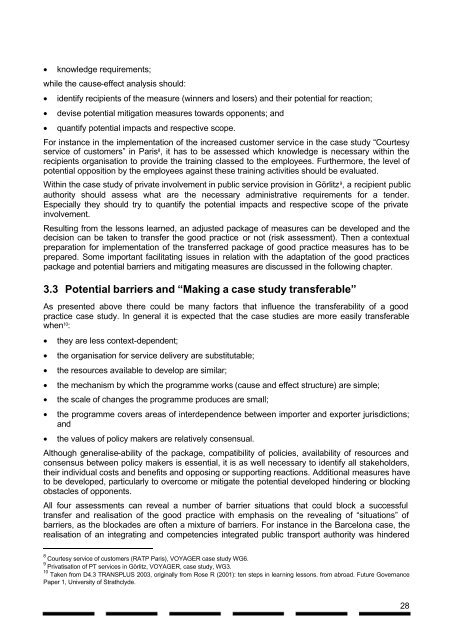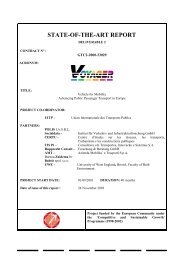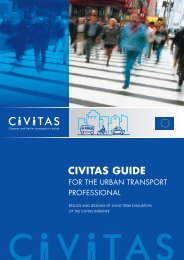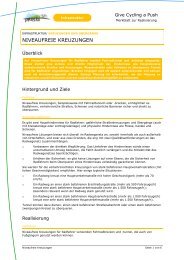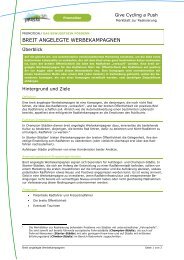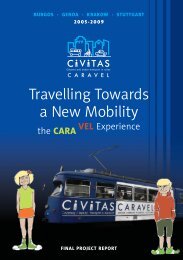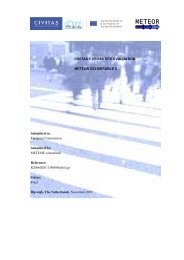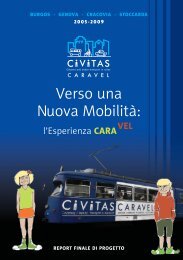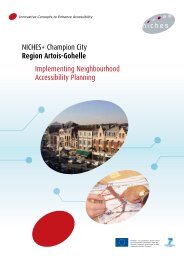VOYAGER Good Practice Case Studies - Rupprecht Consult
VOYAGER Good Practice Case Studies - Rupprecht Consult
VOYAGER Good Practice Case Studies - Rupprecht Consult
You also want an ePaper? Increase the reach of your titles
YUMPU automatically turns print PDFs into web optimized ePapers that Google loves.
• knowledge requirements;<br />
while the cause-effect analysis should:<br />
• identify recipients of the measure (winners and losers) and their potential for reaction;<br />
• devise potential mitigation measures towards opponents; and<br />
• quantify potential impacts and respective scope.<br />
For instance in the implementation of the increased customer service in the case study “Courtesy<br />
service of customers” in Paris 8 , it has to be assessed which knowledge is necessary within the<br />
recipients organisation to provide the training classed to the employees. Furthermore, the level of<br />
potential opposition by the employees against these training activities should be evaluated.<br />
Within the case study of private involvement in public service provision in Görlitz 9 , a recipient public<br />
authority should assess what are the necessary administrative requirements for a tender.<br />
Especially they should try to quantify the potential impacts and respective scope of the private<br />
involvement.<br />
Resulting from the lessons learned, an adjusted package of measures can be developed and the<br />
decision can be taken to transfer the good practice or not (risk assessment). Then a contextual<br />
preparation for implementation of the transferred package of good practice measures has to be<br />
prepared. Some important facilitating issues in relation with the adaptation of the good practices<br />
package and potential barriers and mitigating measures are discussed in the following chapter.<br />
3.3 Potential barriers and “Making a case study transferable”<br />
As presented above there could be many factors that influence the transferability of a good<br />
practice case study. In general it is expected that the case studies are more easily transferable<br />
when 10 :<br />
• they are less context-dependent;<br />
• the organisation for service delivery are substitutable;<br />
• the resources available to develop are similar;<br />
• the mechanism by which the programme works (cause and effect structure) are simple;<br />
• the scale of changes the programme produces are small;<br />
• the programme covers areas of interdependence between importer and exporter jurisdictions;<br />
and<br />
• the values of policy makers are relatively consensual.<br />
Although generalise-ability of the package, compatibility of policies, availability of resources and<br />
consensus between policy makers is essential, it is as well necessary to identify all stakeholders,<br />
their individual costs and benefits and opposing or supporting reactions. Additional measures have<br />
to be developed, particularly to overcome or mitigate the potential developed hindering or blocking<br />
obstacles of opponents.<br />
All four assessments can reveal a number of barrier situations that could block a successful<br />
transfer and realisation of the good practice with emphasis on the revealing of “situations” of<br />
barriers, as the blockades are often a mixture of barriers. For instance in the Barcelona case, the<br />
realisation of an integrating and competencies integrated public transport authority was hindered<br />
8 Courtesy service of customers (RATP Paris), <strong>VOYAGER</strong> case study WG6.<br />
9 Privatisation of PT services in Görlitz, <strong>VOYAGER</strong>, case study, WG3.<br />
10 Taken from D4.3 TRANSPLUS 2003, originally from Rose R (2001): ten steps in learning lessons. from abroad. Future Governance<br />
Paper 1, University of Strathclyde.<br />
28


